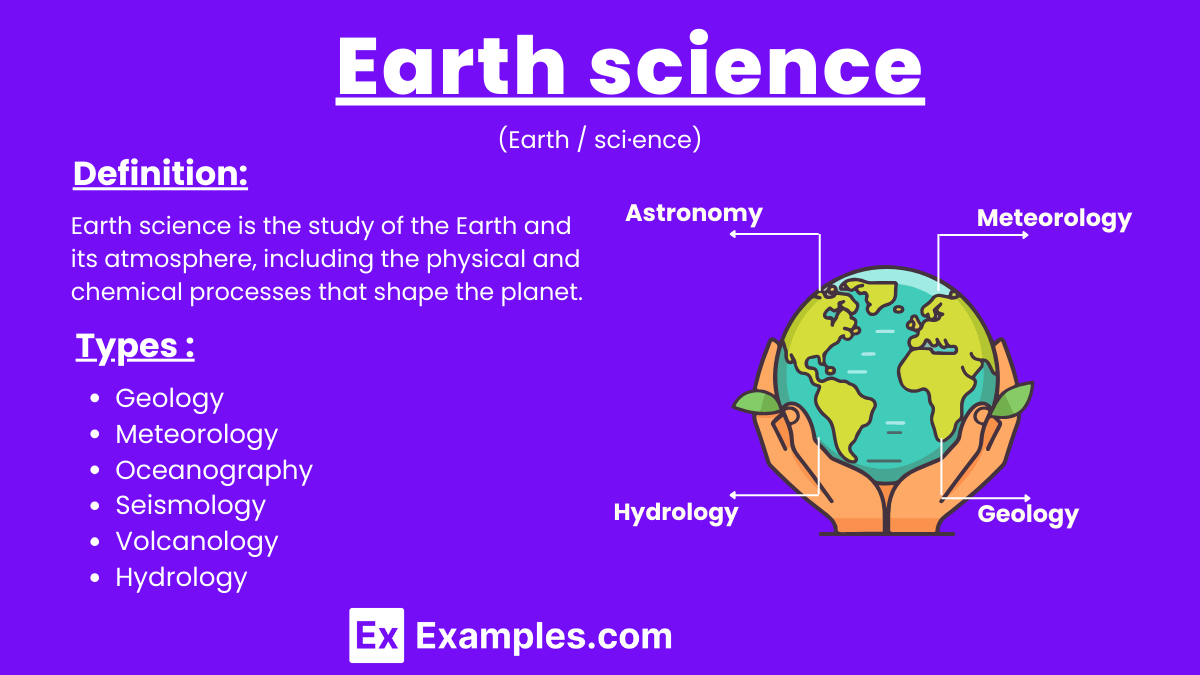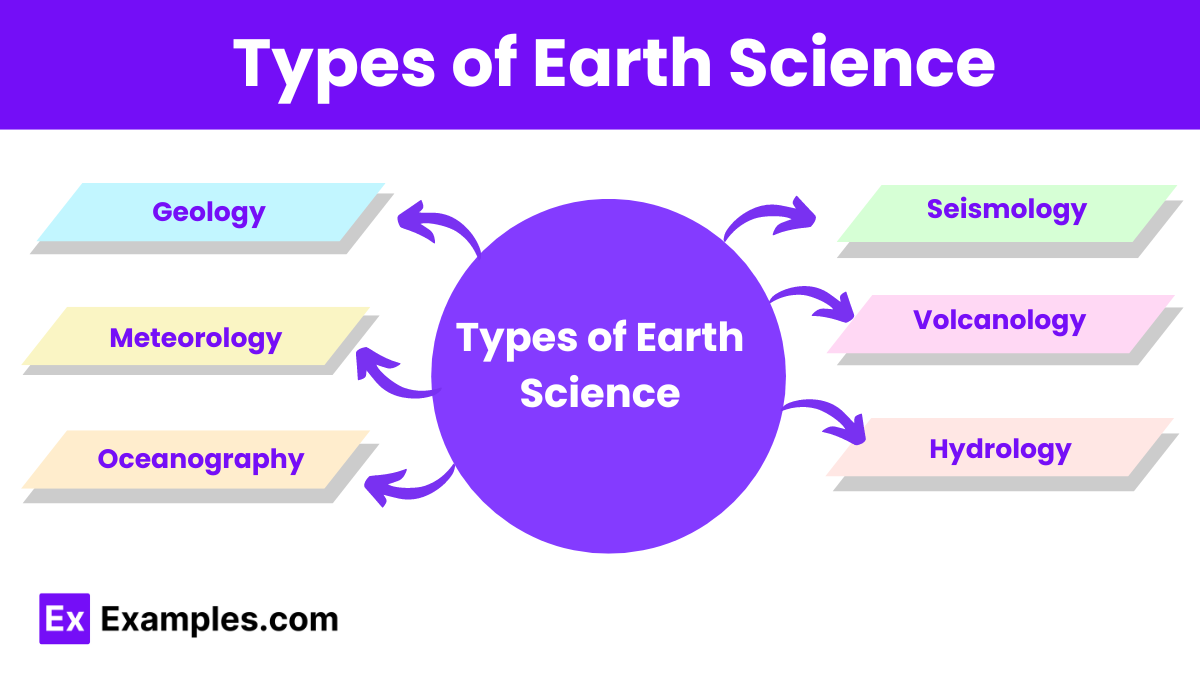Which layer of the Earth is the outermost?
Mantle
Core
Lithosphere
Crust


Earth science is the study of the Earth and its atmosphere, encompassing the various physical and chemical processes that shape the planet’s surface, interior, and its surrounding environment. This broad field includes disciplines such as geology, which examines the Earth’s solid materials and processes; meteorology, focusing on the atmosphere and weather patterns; oceanography, the study of Earth’s oceans; and astronomy, which looks at the Earth’s place in the universe. Earth science integrates knowledge from biology, chemistry, physics, and mathematics to understand natural phenomena and the interactions between the Earth’s systems.
Earth science is the study of the Earth and its atmosphere, including the physical and chemical processes that shape the planet. It encompasses geology, meteorology, oceanography, and astronomy, integrating knowledge from various scientific disciplines to understand natural phenomena and the interactions between the Earth’s systems.

Geology is the study of the Earth’s solid materials, such as rocks and minerals. It involves understanding the processes that have shaped the Earth’s structure over time, including plate tectonics, erosion, and sedimentation. Subfields of geology include petrology (study of rocks), mineralogy (study of minerals), and geophysics (study of the Earth’s physical properties).
Meteorology focuses on the Earth’s atmosphere and weather patterns. Meteorologists study phenomena like storms, climate change, and atmospheric pressure. Their work involves forecasting weather and understanding climate systems to predict changes and help prepare for weather-related disasters.
Oceanography explores the Earth’s oceans and marine environments. This field includes the study of ocean currents, marine ecosystems, and ocean chemistry. Subfields within oceanography include physical oceanography (study of ocean currents and waves), biological oceanography (study of marine organisms), and chemical oceanography (study of the chemical composition of seawater).
Seismology investigates earthquakes and the propagation of seismic waves through the Earth. Seismologists study the Earth’s internal structure by analyzing seismic data, which helps in understanding tectonic activity and predicting earthquakes. This field is crucial for earthquake preparedness and risk mitigation.
Volcanology is the study of volcanoes, lava, magma, and related geological phenomena. Volcanologists investigate volcanic eruptions, the formation of magma, and volcanic hazards. Their research aims to predict eruptions and mitigate the risks associated with volcanic activity.
Hydrology examines the distribution, movement, and properties of water on Earth. This includes studying the water cycle, groundwater flow, and surface water systems. Hydrologists play a vital role in managing water resources and understanding the impacts of water on the environment.
Paleontology is the study of fossils and ancient life forms. Paleontologists reconstruct the Earth’s history and evolutionary processes by analyzing fossilized remains and their geological context. This field provides insights into past climates, environments, and biological evolution.
Glaciology focuses on glaciers and ice sheets, studying their formation, movement, and impact on global sea levels. Glaciologists investigate past glacial periods and current changes in ice cover to understand their effects on the Earth’s climate and sea levels.
Environmental science investigates how natural and human activities affect the Earth’s environment. This interdisciplinary field studies pollution, conservation, and sustainable practices, integrating knowledge from biology, chemistry, and Earth science to address environmental challenges.
Astronomy explores celestial objects and phenomena beyond the Earth’s atmosphere. Astronomers study the universe, including planets, stars, galaxies, and cosmic events, to understand how these celestial bodies influence the Earth and its environment. This field also includes the study of the Earth’s place in the universe.
Earthquakes result from sudden energy release due to tectonic plate movements along faults, causing ground shaking.
The water cycle involves evaporation, condensation, precipitation, and runoff, recycling water through Earth’s atmosphere, surface, and underground.
Volcanoes erupt when magma from beneath Earth’s crust rises, releasing gases and causing lava, ash, and rock ejection.
Climate change refers to significant long-term changes in Earth’s climate patterns, primarily due to human activities like burning fossil fuels.
Tectonic plates are large, rigid sections of Earth’s lithosphere that move over the semi-fluid asthenosphere, causing geological activity.
Glaciers form accumulated snow that compacts into ice over time, typically in polar regions and high mountains.
Mountains form through tectonic forces such as the collision and uplift of Earth’s crustal plates or volcanic activity.
Oceans influence weather by storing and distributing heat and moisture, affecting atmospheric circulation and climate patterns.
Weather refers to short-term atmospheric conditions, while climate describes long-term patterns and averages of weather in a region.
Minerals are naturally occurring, inorganic substances with a definite chemical composition and crystalline structure, forming rocks.

Earth science is the study of the Earth and its atmosphere, encompassing the various physical and chemical processes that shape the planet’s surface, interior, and its surrounding environment. This broad field includes disciplines such as geology, which examines the Earth’s solid materials and processes; meteorology, focusing on the atmosphere and weather patterns; oceanography, the study of Earth’s oceans; and astronomy, which looks at the Earth’s place in the universe. Earth science integrates knowledge from biology, chemistry, physics, and mathematics to understand natural phenomena and the interactions between the Earth’s systems.
Earth science is the study of the Earth and its atmosphere, including the physical and chemical processes that shape the planet. It encompasses geology, meteorology, oceanography, and astronomy, integrating knowledge from various scientific disciplines to understand natural phenomena and the interactions between the Earth’s systems.
Studying the San Andreas Fault: Understanding earthquake activity and tectonic movement in California to predict future seismic events.
Analyzing Hurricane Katrina: Examining meteorological data to understand the formation, path, and impacts of the devastating 2005 hurricane.
Investigating the Great Barrier Reef: Studying coral ecosystems to assess the effects of climate change, ocean acidification, and human activities on marine biodiversity.
Monitoring Mount St. Helens: Observing volcanic activity and the geological processes involved in the 1980 eruption and ongoing volcanic activity.
Exploring the Mid-Atlantic Ridge: Studying the process of seafloor spreading and the creation of new oceanic crust.
Examining Ice Core Samples from Antarctica: Analyzing trapped gases and particles to understand past climate changes and predict future climate trends.
Researching the Dust Bowl: Investigating the causes and effects of severe dust storms in the 1930s Great Plains to learn about soil conservation and sustainable agriculture.
Mapping the Amazon Rainforest: Using satellite imagery to monitor deforestation rates and understand the impact of human activities on tropical ecosystems.
Assessing the Impact of the 2011 Tōhoku Earthquake and Tsunami: Studying the earthquake and resulting tsunami in Japan to improve early warning systems and disaster preparedness.
Evaluating Coastal Erosion in the Outer Banks: Investigating the processes and impacts of coastal erosion to develop strategies for shoreline protection and management.
Geology is the study of the Earth’s solid materials, such as rocks and minerals. It involves understanding the processes that have shaped the Earth’s structure over time, including plate tectonics, erosion, and sedimentation. Subfields of geology include petrology (study of rocks), mineralogy (study of minerals), and geophysics (study of the Earth’s physical properties).
Meteorology focuses on the Earth’s atmosphere and weather patterns. Meteorologists study phenomena like storms, climate change, and atmospheric pressure. Their work involves forecasting weather and understanding climate systems to predict changes and help prepare for weather-related disasters.
Oceanography explores the Earth’s oceans and marine environments. This field includes the study of ocean currents, marine ecosystems, and ocean chemistry. Subfields within oceanography include physical oceanography (study of ocean currents and waves), biological oceanography (study of marine organisms), and chemical oceanography (study of the chemical composition of seawater).
Seismology investigates earthquakes and the propagation of seismic waves through the Earth. Seismologists study the Earth’s internal structure by analyzing seismic data, which helps in understanding tectonic activity and predicting earthquakes. This field is crucial for earthquake preparedness and risk mitigation.
Volcanology is the study of volcanoes, lava, magma, and related geological phenomena. Volcanologists investigate volcanic eruptions, the formation of magma, and volcanic hazards. Their research aims to predict eruptions and mitigate the risks associated with volcanic activity.
Hydrology examines the distribution, movement, and properties of water on Earth. This includes studying the water cycle, groundwater flow, and surface water systems. Hydrologists play a vital role in managing water resources and understanding the impacts of water on the environment.
Paleontology is the study of fossils and ancient life forms. Paleontologists reconstruct the Earth’s history and evolutionary processes by analyzing fossilized remains and their geological context. This field provides insights into past climates, environments, and biological evolution.
Glaciology focuses on glaciers and ice sheets, studying their formation, movement, and impact on global sea levels. Glaciologists investigate past glacial periods and current changes in ice cover to understand their effects on the Earth’s climate and sea levels.
Environmental science investigates how natural and human activities affect the Earth’s environment. This interdisciplinary field studies pollution, conservation, and sustainable practices, integrating knowledge from biology, chemistry, and Earth science to address environmental challenges.
Astronomy explores celestial objects and phenomena beyond the Earth’s atmosphere. Astronomers study the universe, including planets, stars, galaxies, and cosmic events, to understand how these celestial bodies influence the Earth and its environment. This field also includes the study of the Earth’s place in the universe.
Understanding Natural Hazards:
Helps predict and mitigate the impacts of earthquakes, volcanoes, hurricanes, and floods.
Saves lives and reduces economic losses by improving preparedness and response strategies.
Resource Management:
Guides the exploration and sustainable use of natural resources such as minerals, oil, and water.
Promotes efficient land use and conservation practices.
Environmental Protection:
Aids in understanding and addressing environmental issues like climate change, pollution, and deforestation.
Supports the development of strategies to protect ecosystems and biodiversity.
Climate Change Insights:
Provides data on historical climate patterns and current climate dynamics.
Informs policies and actions to combat global warming and its effects.
Advancing Technology and Innovation:
Fuels advancements in technology through the study of Earth’s materials and processes.
Drives innovation in fields such as renewable energy, engineering, and space exploration.
Earthquakes result from sudden energy release due to tectonic plate movements along faults, causing ground shaking.
The water cycle involves evaporation, condensation, precipitation, and runoff, recycling water through Earth’s atmosphere, surface, and underground.
Volcanoes erupt when magma from beneath Earth’s crust rises, releasing gases and causing lava, ash, and rock ejection.
Climate change refers to significant long-term changes in Earth’s climate patterns, primarily due to human activities like burning fossil fuels.
Tectonic plates are large, rigid sections of Earth’s lithosphere that move over the semi-fluid asthenosphere, causing geological activity.
Glaciers form accumulated snow that compacts into ice over time, typically in polar regions and high mountains.
Mountains form through tectonic forces such as the collision and uplift of Earth’s crustal plates or volcanic activity.
Oceans influence weather by storing and distributing heat and moisture, affecting atmospheric circulation and climate patterns.
Weather refers to short-term atmospheric conditions, while climate describes long-term patterns and averages of weather in a region.
Minerals are naturally occurring, inorganic substances with a definite chemical composition and crystalline structure, forming rocks.
Text prompt
Add Tone
10 Examples of Public speaking
20 Examples of Gas lighting
Which layer of the Earth is the outermost?
Mantle
Core
Lithosphere
Crust
What is the primary cause of volcanic eruptions?
Plate tectonics
Solar activity
Atmospheric pressure
Ocean currents
Which type of rock is formed from the cooling and solidification of magma?
Sedimentary
Metamorphic
Igneous
Limestone
What is the Earth's most abundant gas in the atmosphere?
Oxygen
Nitrogen
Carbon dioxide
Argon
Which process describes the movement of rock fragments from one place to another?
Erosion
Metamorphism
Weathering
Compaction
Which layer of the Earth is composed primarily of iron and nickel?
Crust
Mantle
Outer core
Inner core
What type of plate boundary is characterized by plates sliding past each other?
Convergent
Divergent
Transform
Subduction
Which phenomenon is responsible for the formation of mountain ranges?
Erosion
Subduction
Continental drift
Volcanic activity
What causes the seasons on Earth?
Distance from the Sun
Earth's tilt on its axis
Earth's rotation speed
Solar flares
Which type of rock forms from the accumulation and compression of sediment?
Igneous
Metamorphic
Sedimentary
Basalt
Before you leave, take our quick quiz to enhance your learning!

